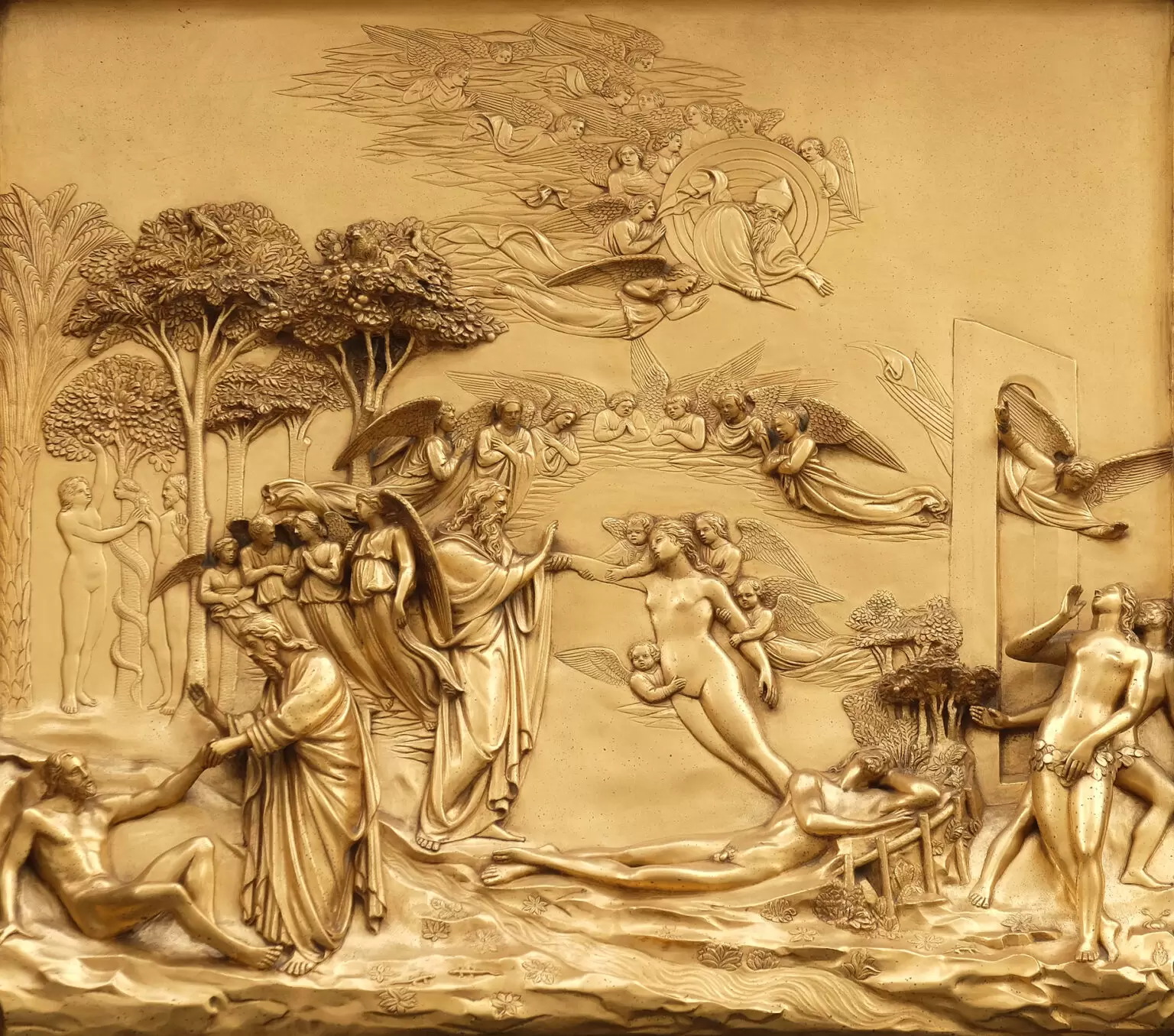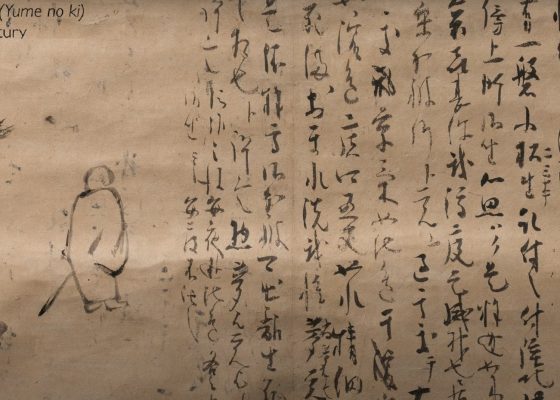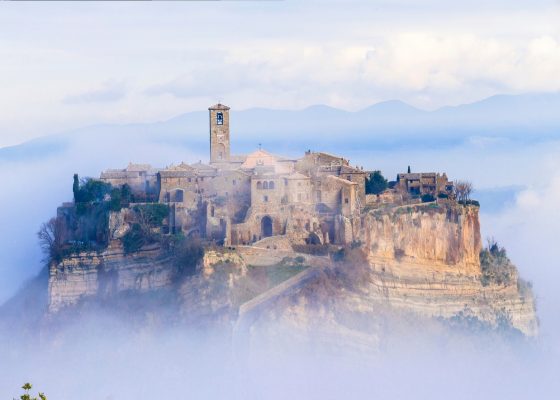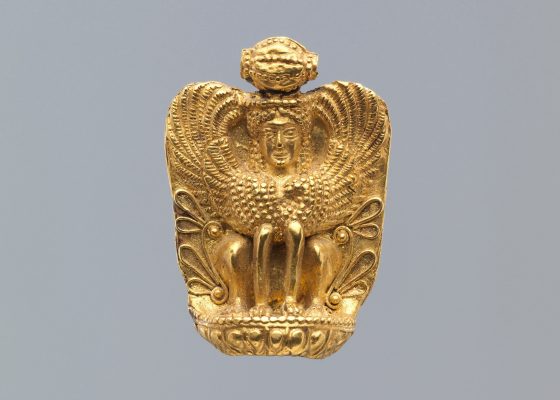
By Staff Middle Land

Lorenzo Ghiberti (1378 – 1 December 1455), born Lorenzo di Bartolo, was a Florentine Italian artist of the Early Renaissance best known as the creator of the bronze doors of the Baptistry of Florence Cathedral, called by Michelangelo the “Gates of Paradise”. Trained as a goldsmith and sculptor, he established an important workshop for sculpture in metal. His book of Commentari contains important writing on art, as well as what may be the earliest surviving autobiography by any artist.
Early life
Ghiberti was born in Pelago, 20 km from Florence. His father was Bartoluccio Ghiberti, an artist and goldsmith, who trained his son in goldsmithing. He then went to work in the Florence workshop of Bartoluccio de Michele, where Brunelleschi also got his training. When the bubonic plague struck Florence in 1400, Ghiberti emigrated to Rimini, where he assisted in the completion of wall frescoes of the castle of Carlo I Malatesta.
Baptistery of San Giovanni

Ghiberti’s career was dominated by his two successive commissions for pairs of bronze doors to the Battistero di San Giovanni or Florence Baptistery. They are recognized as a major masterpiece of the Early Renaissance, and were famous and influential from their unveiling. Ghiberti first became famous when as a 23 year-old he won the 1401 competition for the first set of bronze doors; Brunelleschi was the runner up. The original plan was for the doors to depict scenes from the Old Testament, and the trial piece was the sacrifice of Isaac, which survives. However, the plan was changed to depict scenes from the New Testament, instead.
To carry out this commission, he set up a large workshop in which many artists trained, including Donatello, Masolino, Michelozzo, Uccello, and Antonio Pollaiuolo. When his first set of twenty-eight panels was complete, Ghiberti was commissioned to produce a second set for another doorway in the church, this time with scenes from the Old Testament, as originally intended for his first set. Instead of twenty-eight scenes, he produced ten rectangular scenes in a completely different style. They were more naturalistic, with perspective and a greater idealization of the subject. Michelangelo dubbed these scenes the “Gates of Paradise.” “The Gates of Paradise” is a major monument of the age of Renaissance humanism.
Earlier doors by Andrea Pisano
As recommended by Giotto, Andrea Pisano was awarded the commission to design the first set of doors in 1329. The south doors were originally installed on the east side, facing the Duomo, and were transferred to their present location in 1452. This took six years, the doors being completed in 1336. These proto-Renaissance doors consist of 28 quatrefoil panels, with the twenty top panels depicting scenes from the life of St. John the Baptist. The eight lower panels depict the eight virtues of hope, faith, charity, humility, fortitude, temperance, justice and prudence. The moulded reliefs in the doorcase were added by Ghiberti in 1452. There is a Latin inscription on top of the door: “Andreas Ugolini Nini de Pisis me fecit A.D. MCCCXXX” (Andrea Pisano made me in 1330).
The bronze doors of the Florence Baptistery



It took Ghiberti 21 years to complete these doors. These gilded bronze doors consist of twenty-eight panels, with twenty panels depicting the life of Christ from the New Testament. The eight lower panels show the four evangelists and the Church Fathers Saint Ambrose, Saint Jerome, Saint Gregory and Saint Augustine. The panels are surrounded by a framework of foliage in the door case and gilded busts of prophets and sibyls at the intersections of the panels. Originally installed on the east side, in place of Pisano’s doors, they were later moved to the north side. They are described by the art historian Antonio Paolucci as “the most important event in the history of Florentine art in the first quarter of the 15th century”.[3]
The bronze statues over the northern gate depict John the Baptist preaching to a Pharisee and Sadducee. They were sculpted by Francesco Rustici and are superior to any sculpture he did before. Rustici may have been aided in his design by Leonardo da Vinci, who assisted him in the choice of his tools.
Ghiberti was now widely recognized as a celebrity and the top artist in this field. He was showered with commissions, even from the pope. In 1425 he got a second commission, this time for the east doors of the baptistry, on which he and his workshop (including Michelozzo and Benozzo Gozzoli) toiled for 27 years, excelling themselves. The subjects of the designs for the doors were chosen by Leonardo Bruni d’Arezzo, then chancellor of the Republic of Florence.[4] These had ten panels depicting scenes from the Old Testament, and were in turn installed on the east side. The panels are large rectangles and are no longer embedded in the traditional Gothic quatrefoil, as in the previous doors. Ghiberti employed the recently discovered principles of perspective to give depth to his compositions. Each panel depicts more than one episode. In “The Story of Joseph” is portrayed the narrative scheme of Joseph Cast by His Brethren into the Well, Joseph Sold to the Merchants, The merchants delivering Joseph to the pharaoh, Joseph Interpreting the Pharaoh’s dream, The Pharaoh Paying him Honour, Jacob Sends His Sons to Egypt and Joseph Recognizes His Brothers and Returns Home. According to Vasari’s Lives, this panel was the most difficult and also the most beautiful. The figures are distributed in very low relief in a perspective space (a technique invented by Donatello and called rilievo schiacciato, which literally means “flattened relief”.) Ghiberti uses different sculptural techniques, from incised lines to almost free-standing figure sculpture, within the panels, further accentuating the sense of space.
The panels are included in a richly decorated gilt framework of foliage and fruit, many statuettes of prophets and 24 busts. The two central busts are portraits of the artist and of his father, Bartolomeo Ghiberti.
Although the overall quality of the casting is exquisite, some mistakes have been made. For example, in panel 15 of the North Doors (Flagellation) the casting of the second column in the front row has been mistakenly overlaid over an arm, so that one of the flagellators looks trapped in stone, with his hand sticking out of it.[5]
Michelangelo referred to these doors as fit to be the “Gates of Paradise” (It. Porte del Paradiso), and they are still invariably referred to by this name. Giorgio Vasari described them a century later as “undeniably perfect in every way and must rank as the finest masterpiece ever created”. Ghiberti himself said they were “the most singular work that I have ever made”.
Gates of Paradise | Lorenzo Ghiberti, Story of Abel and Cain

1. Adam and Eve

The Adam and Eve Panel documents Ghiberti’s earliest work on the doors and features a splendid depiction of nude figures in a landscape set off by angelic hosts. Ghiberti combined four major episodes from the story of Adam and Eve into this harmonious panel. The creation of Adam, illustrated in the foreground on the far left, shows Adam in a state of semiconsciousness, rising in response to God’s life-giving touch. In the center, as angels look on, God forms Eve from one of Adam’s ribs. The temptation of Adam and Eve by the serpent is shown in the background on the left, while the right side of the panel depicts the couple’s expulsion from Eden. Subtle shifts in the scale of the figures reinforce discrete episodes in the story of the Creation. Ghiberti modulated the scale and degree of projection of the angels to visually separate the four scenes[11].
2. Cain and Abel
3. Noah
4. Abraham
5. Isaac with Esau and Jacob
In the Jacob and Esau Panel, Ghiberti employed a new system of linear perspective to construct the narrative. He arranged the episodes of the story around a vanishing point framed by the central arch of a Renaissance loggia. This panel, with its nearly three-dimensional foreground figures, masterful use of scientific perspective, and impressive architecture, shows that the artist was at the vanguard of Florentine illusionism and storytelling. In the panel, Jacob obtains the birthright of his elder brother, Esau, and the blessing of their father, Isaac, thus becoming the founder of the Israelites. Rebekah is shown giving birth to the twins beneath the arcade on the far left. On the rooftop in the upper right, Ghiberti depicted her receiving the prophecy of her sons’ future conflict.
Framed inside the central arch, Esau sells his rights as firstborn to Jacob, who offers his hungry brother a bowl of soup in exchange. In the front center of the panel, Isaac sends Esau hunting, and, in the right foreground, Jacob kneels before the blind Isaac, who, feeling a hairy goatskin on Jacob’s back, believes him to be Esau and mistakenly gives him the blessing due to the eldest son.[11]
6. Joseph
7. Moses
8. Joshua
9. David
In the David Panel, Ghiberti illustrated the young David’s victory over the giant Goliath. David is shown in the foreground cutting off the giant’s head after knocking him down with a stone. Above this episode, King Saul—clearly labeled and elevated over the fighting Israelites and Philistines—leads his troops in a rout of the enemy. A cleft in the mountains beyond reveals David and his followers carrying Goliath’s head in triumph toward Jerusalem.[11]
10. Solomon and the Queen of Sheba.
South and north doors


Original publication: Art in Tuscany






Cancel anytime


Using our website
You may use the The Middle Land website subject to the Terms and Conditions set out on this page. Visit this page regularly to check the latest Terms and Conditions. Access and use of this site constitutes your acceptance of the Terms and Conditions in-force at the time of use.
Intellectual property
Names, images and logos displayed on this site that identify The Middle Land are the intellectual property of New San Cai Inc. Copying any of this material is not permitted without prior written approval from the owner of the relevant intellectual property rights.
Requests for such approval should be directed to the competition committee.
Please provide details of your intended use of the relevant material and include your contact details including name, address, telephone number, fax number and email.
Linking policy
You do not have to ask permission to link directly to pages hosted on this website. However, we do not permit our pages to be loaded directly into frames on your website. Our pages must load into the user’s entire window.
The Middle Land is not responsible for the contents or reliability of any site to which it is hyperlinked and does not necessarily endorse the views expressed within them. Linking to or from this site should not be taken as endorsement of any kind. We cannot guarantee that these links will work all the time and have no control over the availability of the linked pages.
Submissions
All information, data, text, graphics or any other materials whatsoever uploaded or transmitted by you is your sole responsibility. This means that you are entirely responsible for all content you upload, post, email or otherwise transmit to the The Middle Land website.
Virus protection
We make every effort to check and test material at all stages of production. It is always recommended to run an anti-virus program on all material downloaded from the Internet. We cannot accept any responsibility for any loss, disruption or damage to your data or computer system, which may occur while using material derived from this website.
Disclaimer
The website is provided ‘as is’, without any representation or endorsement made, and without warranty of any kind whether express or implied.
Your use of any information or materials on this website is entirely at your own risk, for which we shall not be liable. It is your responsibility to ensure any products, services or information available through this website meet your specific requirements.
We do not warrant the operation of this site will be uninterrupted or error free, that defects will be corrected, or that this site or the server that makes it available are free of viruses or represent the full functionality, accuracy and reliability of the materials. In no event will we be liable for any loss or damage including, without limitation, loss of profits, indirect or consequential loss or damage, or any loss or damages whatsoever arising from the use, or loss of data, arising out of – or in connection with – the use of this website.
Last Updated: September 11, 2024
New San Cai Inc. (hereinafter “The Middle Land,” “we,” “us,” or “our”) owns and operates www.themiddleland.com, its affiliated websites and applications (our “Sites”), and provides related products, services, newsletters, and other offerings (together with the Sites, our “Services”) to art lovers and visitors around the world.
This Privacy Policy (the “Policy”) is intended to provide you with information on how we collect, use, and share your personal data. We process personal data from visitors of our Sites, users of our Services, readers or bloggers (collectively, “you” or “your”). Personal data is any information about you. This Policy also describes your choices regarding use, access, and correction of your personal information.
If after reading this Policy you have additional questions or would like further information, please email at middleland@protonmail.com.
PERSONAL DATA WE COLLECT AND HOW WE USE IT
We collect and process personal data only for lawful reasons, such as our legitimate business interests, your consent, or to fulfill our legal or contractual obligations.
Information You Provide to Us
Most of the information Join Talents collects is provided by you voluntarily while using our Services. We do not request highly sensitive data, such as health or medical information, racial or ethnic origin, political opinions, religious or philosophical beliefs, trade union membership, etc. and we ask that you refrain from sending us any such information.
Here are the types of personal data that you voluntarily provide to us:
As a registered users or customers, you may ask us to review or retrieve emails sent to your business. We will access these emails to provide these services for you.
We use the personal data you provide to us for the following business purposes:
Information Obtained from Third-Party Sources
We collect and publish biographical and other information about users, which we use to promote the articles and our bloggers who use our sites. If you provide personal information about others, or if others give us your information, we will only use that information for the specific reason for which it was provided.
Information We Collect by Automated Means
Log Files
The site uses your IP address to help diagnose server problems, and to administer our website. We use your IP addresses to analyze trends and gather broad demographic information for aggregate use.
Every time you access our Site, some data is temporarily stored and processed in a log file, such as your IP addresses, the browser types, the operating systems, the recalled page, or the date and time of the recall. This data is only evaluated for statistical purposes, such as to help us diagnose problems with our servers, to administer our sites, or to improve our Services.
Do Not Track
Your browser or device may include “Do Not Track” functionality. Our information collection and disclosure practices, and the choices that we provide to customers, will continue to operate as described in this Privacy Policy, whether or not a “Do Not Track” signal is received.
HOW WE SHARE YOUR INFORMATION
We may share your personal data with third parties only in the ways that are described in this Privacy Policy. We do not sell, rent, or lease your personal data to third parties, and We does not transfer your personal data to third parties for their direct marketing purposes.
We may share your personal data with third parties as follows:
There may be other instances where we share your personal data with third parties based on your consent.
HOW WE STORE AND SECURE YOUR INFORMATION
We retain your information for as long as your account is active or as needed to provide you Services. If you wish to cancel your account, please contact us middleland@protonmail.com. We will retain and use your personal data as necessary to comply with legal obligations, resolve disputes, and enforce our agreements.
All you and our data are stored in the server in the United States, we do not sales or transfer your personal data to the third party. All information you provide is stored on a secure server, and we generally accepted industry standards to protect the personal data we process both during transmission and once received.
YOUR RIGHTS/OPT OUT
You may correct, update, amend, delete/remove, or deactivate your account and personal data by making the change on your Blog on www.themiddleland.com or by emailing middleland@protonmail.com. We will respond to your request within a reasonable timeframe.
You may choose to stop receiving Join Talents newsletters or marketing emails at any time by following the unsubscribe instructions included in those communications, or you can email us at middleland@protonmail.com
LINKS TO OTHER WEBSITES
The Middle Land include links to other websites whose privacy practices may differ from that of ours. If you submit personal data to any of those sites, your information is governed by their privacy statements. We encourage you to carefully read the Privacy Policy of any website you visit.
NOTE TO PARENTS OR GUARDIANS
Our Services are not intended for use by children, and we do not knowingly or intentionally solicit data from or market to children under the age of 18. We reserve the right to delete the child’s information and the child’s registration on the Sites.
PRIVACY POLICY CHANGES
We may update this Privacy Policy to reflect changes to our personal data processing practices. If any material changes are made, we will notify you on the Sites prior to the change becoming effective. You are encouraged to periodically review this Policy.
HOW TO CONTACT US
If you have any questions about our Privacy Policy, please email middleland@protonmail.com
The Michelin brothers created the guide, which included information like maps, car mechanics listings, hotels and petrol stations across France to spur demand.
The guide began to award stars to fine dining restaurants in 1926.
At first, they offered just one star, the concept was expanded in 1931 to include one, two and three stars. One star establishments represent a “very good restaurant in its category”. Two honour “excellent cooking, worth a detour” and three reward “exceptional cuisine, worth a
Thank you for your participation,
please Log in or Sign up to Vote

123Sign in to your account